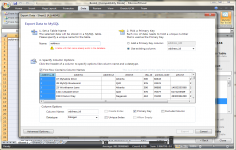 MySQL 5.5.15
MySQL 5.5.15
MySQL AB - (Open Source)
MySQL is a successful open source database used in most web applications, e-commerce and online transaction processing.
MySQL is one of the world's most famous and used open source database. The software can be used to manage web applications, e-commerce and online transaction processing since MySQL database incorporates support those transactions. It is also commonly associated with PHP when it comes to managing websites.
With standard JDBC , ODBC, and Net, the developer can choose the programming language. MySQL has the advantage of working with almost all the popular operating systems and communicate easily with programming languages ​​such as C, C + +, VB, C #, PHP, Python, Ruby, Java, Perl, Eiffel, etc.MySQL replication allows you to create profitable applications. In addition, it enables the development of typologies replication complex and massive chain.Its reliability and robustness, performance, ease of use makes MySQL have more success than anticipated.
- Title:
- MySQL 5.5.15
- File Size:
- 27.8 MB
- Requirements:
- Windows 9x / 2000 / XP / Vista / Windows7 / Windows8
- Language:
- en-us
- License:
- Open Source
- Date Added:
- 27 Jul 2011
- Publisher:
- MySQL AB
- Homepage:
- http://www.mysql.com
- MD5 Checksum:
- 6D6B482D467BB3D26F935AF6EEE63F7E
# Bugs Fixed :
* InnoDB Storage Engine: A failed CREATE INDEX operation for an InnoDB table could result in some memory being allocated and not freed. This memory leak could affect tables created with the ROW_FORMAT=DYNAMIC and ROW_FORMAT=COMPRESSED settings.
* Partitioning: Auto-increment columns of partitioned tables were checked even when they were not being written to. In debug builds, this could lead to a crash of the server.
* Partitioning: The UNIX_TIMESTAMP() function was not treated as a monotonic function for purposes of partition pruning.
* Replication: If a LOAD DATA INFILE statement—replicated using statement-based replication—featured a SET clause, the name-value pairs were regenerated using a method (Item::print()) intended primarily for generating output for statements such as EXPLAIN EXTENDED, and which cannot be relied on to return valid SQL. This could in certain cases lead to a crash on the slave. To fix this problem, we now name each value in its original, user-supplied form, and use that to create LOAD DATA INFILE statements for statement-based replication.
* Previously, an inappropriate error message was produced if a multiple-table update for an InnoDB table with a clustered primary key would update a table through multiple aliases, and perform an update that may physically move the row in at least one of these aliases. Now the error message is: Primary key/partition key update is not allowed since the table is updated both as 'tbl_name1' and 'tbl_name2'
* ALTER TABLE {MODIFY|CHANGE} ... FIRST did nothing except rename columns if the old and new versions of the table had exactly the same structure with respect to column data types. As a result, the mapping of column name to column data was incorrect. The same thing happened for ALTER TABLE DROP COLUMN, ADD COLUMN statements intended to produce a new version of table with exactly the same structure as the old version.
* Incorrect handling of metadata locking for FLUSH TABLES WITH READ LOCK for statements requiring prelocking caused two problems:
- Execution of any data-changing statement that required prelocking (that is, involved a stored function or trigger) as part of transaction slowed down somewhat all subsequent statements in the transaction. Performance in a transaction that periodically involved such statements gradually degraded over time.
- Execution of any data-changing statement that required prelocking as part of transaction prevented a concurrent FLUSH TABLES WITH READ LOCK from proceeding until the end of transaction rather than at the end of the particular statement.
* The fractional part of the “Queries per second†value in MySQL status output could be displayed incorrectly.
* LOAD DATA INFILE incorrectly parsed relative data file path names that ascended more than three levels in the file system and as a consequence was unable to find the file.
* For MyISAM tables, attempts to insert incorrect data into an indexed GEOMETRY column could result in table corruption.
* In debug builds, Field_new_decimal::store_value() was subject to buffer overflows.
* A race condition between loading a stored routine using the name qualified by the database name and dropping that database resulted in a spurious error message: The table mysql.proc is missing, corrupt, or contains bad data
Related software
4.7/5 from 47 users


